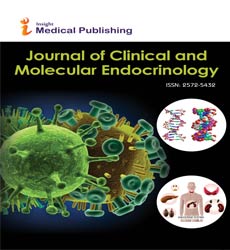Potassium Channels Couple to 1,25(OH)2 Vitamin D3 Rapid Responses and Secretion in Immature Sertoli Cells
Danusa Menegaz, Carlos Ramiro Trejes Dornelles, Fernanda Carvalho Cavalari, Renata Gonçalves, and Fátima Regina Mena Barreto Silva
Danusa Menegaz1,2, Carlos Ramiro Trejes Dornelles1,2, Fernanda Carvalho Cavalari1,2, Renata Gonçalves1, and Fátima Regina Mena Barreto Silva1,2*
1Department of Biochemistry Biological Sciences Center, Federal University of Santa Catarina, University Campus, Trindade, Postal Code 5069, Florianópolis, SC, Brazil
2Nucleus of Cell Bioelectricity (NUBIOCEL) Biological Sciences Center, Federal University of Santa Catarina, University Campus, Trindade, Postal Code 5069, Florianópolis, SC, Brazil
- *Corresponding Author:
- Silva. FRMB
Department of Biochemistry
Center for Biological Sciences
Federal University of Santa Catarina
Florianópolis, SC, Brazil
Tel: +554837216912
Fax: +55-4837219672
E-mail: mena.barreto@ufsc.br
Received date: November 07, 2016; Accepted date: November 17, 2016; Published date: November 20, 2016
Citation: Menegaz D, Dornelles CRT, Cavalari FC, Gonçalves R and Silva FRMB (2016) Potassium Channels Couple to 1,25(OH)2 Vitamin D3 Rapid Responses and Secretion in Immature Sertoli Cells. J Clin Mol Endocrinol 1:33. doi: 10.21767/2572-5432.100031
Copyright: © 2016 Menegaz D. This is an open access article distributed under the terms of the Creative Commons Attribution License, which permits unrestricted use, distribution, and reproduction in any medium, provided the original author and source are credited.
Letter to Editor
The well-known effect of the active form of vitamin D3, 1,25(OH)2 vitamin D3 (1,25-D3), on calcium metabolism, cell proliferation and differentiation is mediated by genomic and nongenomic action [1,2]. The wide 1,25-D3 receptors distribution and the expression of 1α-hydroxylase in the male reproductive tract reinforces a pivotal role of this hormone for the active and complete spermatogenesis [3-5].
The Sertoli cell in the seminiferous tubules provides structural and nutritional support for the healthy development of germ cells [6]. The secretory functions of Sertoli cell depend on the activation of ionic channels which are regulated by 1,25-D3 rapid responses to induce exocytosis of a fluid rich in ions, proteins and growth factors critical for male fertility [7,8]. Studies carried out by our group over the last years have revealed important aspects regarding the effects of 1,25-D3 stimulation of calcium influx by different ionic channels and signal transduction pathways, including cross talk by second messengers modulating the channel activities [9].
The electrophysiological properties of Sertoli cells indicate that the precise control of the electrochemical gradient is involved in the maintenance of the secretory process [7,9]. The addition of high K+ in the extracellular media caused a strong depolarization of Sertoli cells followed by repolarization with the efflux of potassium ions through the voltage-gated K+ channels. In the presence of 1,25-D3, the efflux of K+ ions was recorded after 10 minutes of incubation and it was blocked by TEA, indicating a secretory activity of Sertoli cell through the Ca2+ conventional secretory pathway.
Our new data shows the stimulatory effect of 1,25-D3 on whole-cell K+ currents inhibited by tetraethylammonium, TEA, a broad-spectrum blocker of potassium channels indicating a repolarization of the Sertoli cell after stimulus. Stimulussecretion coupling in Sertoli cells involves multiple ionic channels that regulate the plasma membrane potential, intracellular calcium and secretion. Repolarization of the membrane potential is mediated by several K+-selective ionic channel proteins such as ATP sensitive potassium channel (KATP), voltage-gated channels (Kv), and Ca2+-activated K+ channels (KCa).
In summary, our results demonstrate for the first time that nongenomic 1,25-D3 potentiation of potassium currents couple to exocytosis in primary culture of Sertoli cells. This effect appears to involve Ca2+ influx leading to K+ efflux and repolarization. We conclude that the steroid hormone 1,25-D3 appears to play a functional role in male fertility via stimulation of Sertoli cell secretory activities in the testis.
References
- Demay MB, Gerardi JM, Deluca HF, Kronenberg HM (1990) DNA sequences in the rat osteocalcin gene that bind the 1,25-dihydroxyvitamin D receptor and confer responsiveness to 1,25-dihydroxybitamin D3. Proc Natl Acad Sci USA 87: 369–373.
- Bouillon R, Okamura WH, Norman AW (1995) Structure–function relationships in the vitamin D endocrine system. Endocr Rev 16: 200–257.
- J. Merke, U. Hugel, and E. Ritz (1985) Nuclear testicular 1,25dihydroxyvitamin D3 receptors in Sertoli cells and seminiferous tubules of adult rodents. Biochem Biophys Res Comm127: 303–309.
- Zanatta L, Zamoner A, Gonçalves R, Zanatta AP, Bouraïma-Lelong H, et al. (2011) Effect of 1α,25-dihydroxyvitamin D3 in plasma membrane targets in immature rat testis: Ionic channels and gamma-glutamyl transpeptidase activity. Arch Biochem Biophys 515: 46–53.
- Mahmoudi , Zarnani AH, Jeddi-Tehrani M (2013) Distribution of vitamin D receptor and 1 hydroxylase in male mouse reproductive tract. Rep Sci 20: 426– 436.
- Griswold MD (1995) Interactions between germ cells and Sertoli cells in the testis. Biol Rep 52: 211–216.
- Menegaz D, Barrientos-Duran A, Kline A, Silva FR, Norman AW, et al. (2010) 1α,25(OH)2-vitamin D3 stimulation of secretion via chloride channel activation in Sertoli cells. J Steroid Biochem Mol Biol 119: 127–134.
- Fok KL, Chen H, Ruan YC, Chan HC (2014) Novel regulators of spermatogenesis. Sem Cell & Dev Biol 29: 31–42.
- Rosso A, Pansera M, Zamoner A, Zanatta L, Bouraima-Lelong H, et al. (2012) 1,25(OH)2 vitamin D3 stimulates rapid plasma membrane calcium influx via MAPK activation in immature rat Sertoli cells. Biochimie 94: 146 -154.
Open Access Journals
- Aquaculture & Veterinary Science
- Chemistry & Chemical Sciences
- Clinical Sciences
- Engineering
- General Science
- Genetics & Molecular Biology
- Health Care & Nursing
- Immunology & Microbiology
- Materials Science
- Mathematics & Physics
- Medical Sciences
- Neurology & Psychiatry
- Oncology & Cancer Science
- Pharmaceutical Sciences
